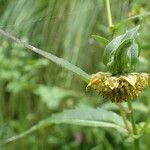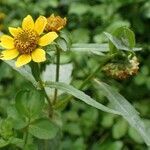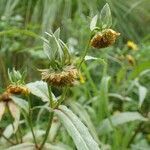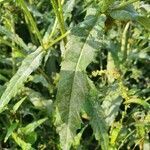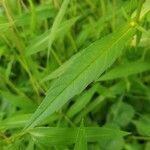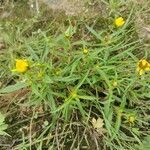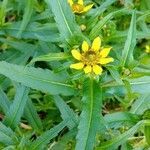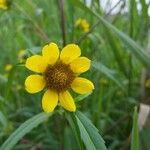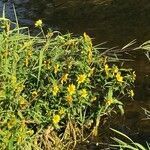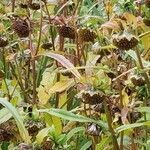Annuals, 10-100 cm tall. Leaves sessile; blade ovate-lanceolate or oblanceolate to lanceolate or linear, 40-100(-200) × (2-)5-25(-45) mm, both surfaces glabrous, base cuneate to rounded, margin usually coarsely dentate to serrate, sometimes entire, sometimes ciliate, apex acute to acuminate. Capitula radiate, rarely discoid, solitary or in lax corymbs; peduncles 10-40(-100+) mm; calycular bracts (3-)5-8(-10), spreading to reflexed, oblong to linear-lanceolate, often ± leaflike, (3-)8-12(-25) mm, abaxially usually glabrous, bases sometimes hispidulous, margin usually ciliate; involucres hemispheric or broader, (3-)6-10 × (8-)12-20+ mm; phyllaries 6-8+, ovate or ovate-lanceolate to lanceolate, 2-10 mm. Ray florets usually 6-8, sometimes absent; lamina orange-yellow, 2-15(-18) mm. Disk florets (10-)40-100(-150+); corollas orange-yellow, 3-4 mm. Achenes blackish or brown, usually flattened, sometimes 4-angled, cuneate, outer (3-)5-6 mm, inner 4-8 mm, faces ± striate, glabrous or tuberculate-strigillose, margin thickened or winged, retrorsely ciliate, apices truncate to convex; pappus of (2-)4 retrorsely barbed awns (1-)2-4 mm. Fl. Aug-Oct. 2n = 24, 48.
Annual 1–10(–40) dm, glabrous or the stem scabrous-hispid; lvs sessile, often basally connate, simple, lance-linear to lance-ovate, coarsely serrate to subentire, 4–20 x 0.5–4.5 cm; heads hemispheric, many-fld, the disk 12–25 mm wide, commonly nodding at least in age; outer invol bracts 5–10, lance-linear, unequal, usually rather leafy and spreading, commonly surpassing the disk; rays (6–)8, yellow, to 1.5 cm, or none; receptacular bracts thin and soft, mostly yellowish at the blunt tip; disk-corollas mostly 5-lobed; anthers shortly exserted; achenes 5–8 mm, the margins tending to be thickened, cartilaginous, and pale at maturity, as also the finally convex (broadly dome-shaped) summit; pappus of (2–)4 retrorsely barbed awns; 2n=24. Low, wet places; widespread in temp. parts of the N. Hemisphere, and throughout our range. Aug.–Oct. (B. elliptica; B. filamentosa; B. glaucescens; B. gracilenta; B. leptopoda; B. prionophylla)
